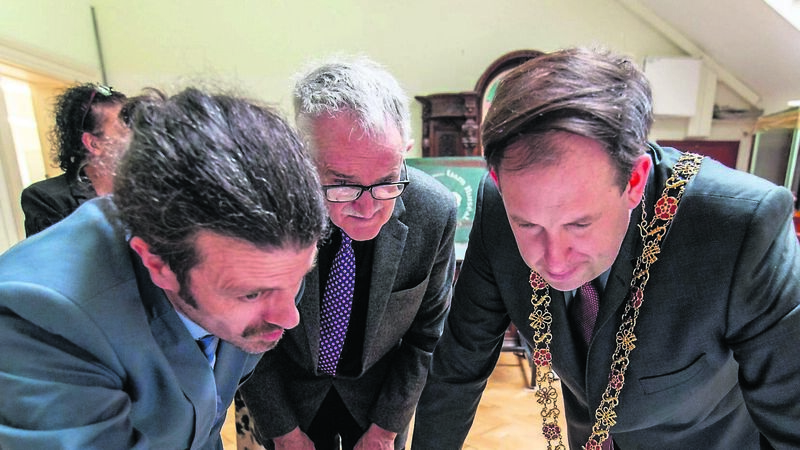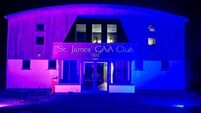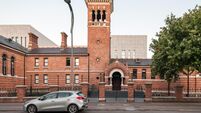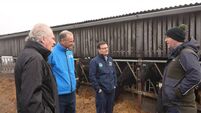Lord Mayor's column: Commemorating those who made sacrifices during the War of Independence

SPEC: Curator of the Cork Public Libray and Richard Beamish showing the Lord Mayor of Cork Councillor Kieran McCarthy, additional information relating to the shaving kit belonmging to Leo Murphy, the IRA cimmander who was killed during the War of Independence: Cork Public Museum hosted an event to mark the return to Cork of a small shaving kit used by Commandant Leo Murphy who died at the hands of Crown Forces during the War of Independence. Picture: Noel Sweeney
CORK continues its journey and commitment to commemorate those who made sacrifices during the War of Independence.
Two projects, which I engaged with in recent weeks show the continued need to engage with its War of Independence to keep researching for lost objects and to keep evolving the presentation of the stories to the public.
Leo Murphy’s Shaving Kit, 1921:
Recently Cork Public Museum marked the return to Cork of a small shaving kit used by Commandant Leo Murphy who died at the hands of Crown Forces during the War of Independence in 1921.
Leo Murphy had been targeted by Crown Forces for his role as Commander of the 3rd Battalion, 1st Cork Brigade and his involvement in numerous notable IRA activities in the area, including the killing of British intelligence officer Captain Joseph Thompson in November 1920.
He was shot and killed by soldiers from the Manchester Regiment during a surprise raid on a secret IRA meeting at O’Donovan’s Pub (now O’Shea’s) in Waterfall, on the outskirts of the city, on 27 June 1921. As Leo lay dead at the side of the road, his pockets were searched, and the contents kept as ‘souvenirs of war’.
One of the items removed was a small personal shaving kit used by Leo Murphy while on the run. It ended up in display in the Manchester Regiment Museum in the town hall of Ashton-under-Lyne, in Tameside, Greater Manchester.
The museum recently closed, and the Manchester Regiment Collection passed to the care of the Portland Basin Museum in Tameside.
Last year, Cork Public Museum Curator Dan Breen contacted his counterpart in the Portland Basin Museum, Rachel Crnes to enquire about the possibility of arranging the loan of the shaving kit for display in Cork.
The descendants of Walter ‘Leo’ Murphy came to the museum for a private viewing of the shaving kit before it went on public display.
The shaving kit will be displayed in the museum’s War of Independence exhibition, By Every Means at Our Command, alongside one of Leo Murphy’s hats, which was previously donated to Cork Public Museum.
In mid-January this year, as Lord Mayor, I travelled with Dan Breen to Tameside to officially receive the shaving kit taken by Captain Vinning and the Manchester Regiment and to bring it home to Cork.
I visited Dukinfield Town Hall and was greeted by Dublin-born Deputy Mayor of Tameside, Cllr. Betty Affleck, and executive leader, Cllr. Gerald Cooney (also of Irish descent).
Cork Public Museum Curator, Dan Breen on the occasion noted: “Cork City Council and Cork Public Museum would like to acknowledge the help and support given to the handover by their colleagues in Tameside Metropolitan Borough Council and the Portland Basin Museum.
“The return of the shaving kit to Cork brings closure to one chapter of Irish War of Independence but it highlights the complex history shared by the cities of Cork and Manchester and acknowledges the potential for future collaborations to better understand it”.
From his early days in Fianna Éireann, Leo Murphy’s story was one of courage and resilience. His promotion to quarter master of the 3rd Battalion by the age of nineteen in 1920, is an indication of his leadership qualities and the high esteem in which he was held by all within the Cork IRA.
The commemoration of his life and times in our time shines a spotlight on his leadership and sacrifice. It also, through the Tameside Museum side, showcases why we need to keep searching for objects and documents associated with our War of Independence to make sure the full story is told.
Ballycannon Boys Memorial Park:
In recent weeks the Ballycannon Boys Memorial Park, created by local community group of Clogheen/ Kerry Pike Community Association, has been unveiled.
The park complements the nearby memorial (1945) and honours the memory of six young IRA men that were killed by Black and Tans on 23 March 1921.
The six men killed were Daniel Crowley of Blarney Street (aged 22), William Deasy of Mount Desert, Blarney Road (aged 20 years), Thomas Dennehy of Blarney Street (aged 21 years), Daniel Murphy of Orrey Hill (aged 24 years), Jeremiah O’Mullane of Blarney Street (aged 23), and Michael O’Sullivan of Blarney Street (aged 20 years).
The new and detailed information panels in the park highlight that early in the morning of the 23 March 1921, a number of lorries left police barracks in Cork loaded with Black and Tans, British born recruits to the Royal Irish Constabulary (RIC) who wore khaki uniforms & the black belts and caps of the RIC.
The Black and Tans were feared for their ruthlessness and lack of discipline.
The lorries drove out to Kerry Pike where the Tans dismounted and made their way silently over the road, crossing the fields, approaching and surrounding the O’Keeffe farmyard. They banged on the front door demanding admittance, and having woken the terrified household began searching the house, then spread out to search the outbuildings, catching the six young men asleep and unarmed in the tack room next to the stables.
What happened next is contested, but it appears that some of the six young men were dragged outside and mistreated as the police demanded to know where they had hidden their arms. There was an attempted break-out as they tried to escape through the surrounding fields.
But a cordon had been posted and one by one the young men were picked off in a hail of high velocity rifle fire and revolver bullets. Some of the bodies were horribly mutilated, some showed marks of having been shot at close range.
The Ballycannon tragedy must also be viewed in the broader context of what was happening elsewhere. During the eight months leading up until the Truce of July 1921, there was a spiralling of the death toll in the conflict, with 1,000 people including the RIC police, British military, IRA volunteers and civilians, being killed in the months between January and July 1921 alone.
This represents about 70% of the total casualties for the entire three-year conflict.
In addition, 4,500 IRA personnel (or suspected sympathisers) were interned in this time. In the middle of this violence, the Dáil formally declared war on Britain in March 1921. Between 1 November 1920 and 7 June 1921 twenty four men were executed by the British.
My thanks to all our community groups in our city, who champion our War of Independence past and indeed other local history stories. All such stories underpin Cork’s rich sense of place and identity.
More in this section







 App?
App?


